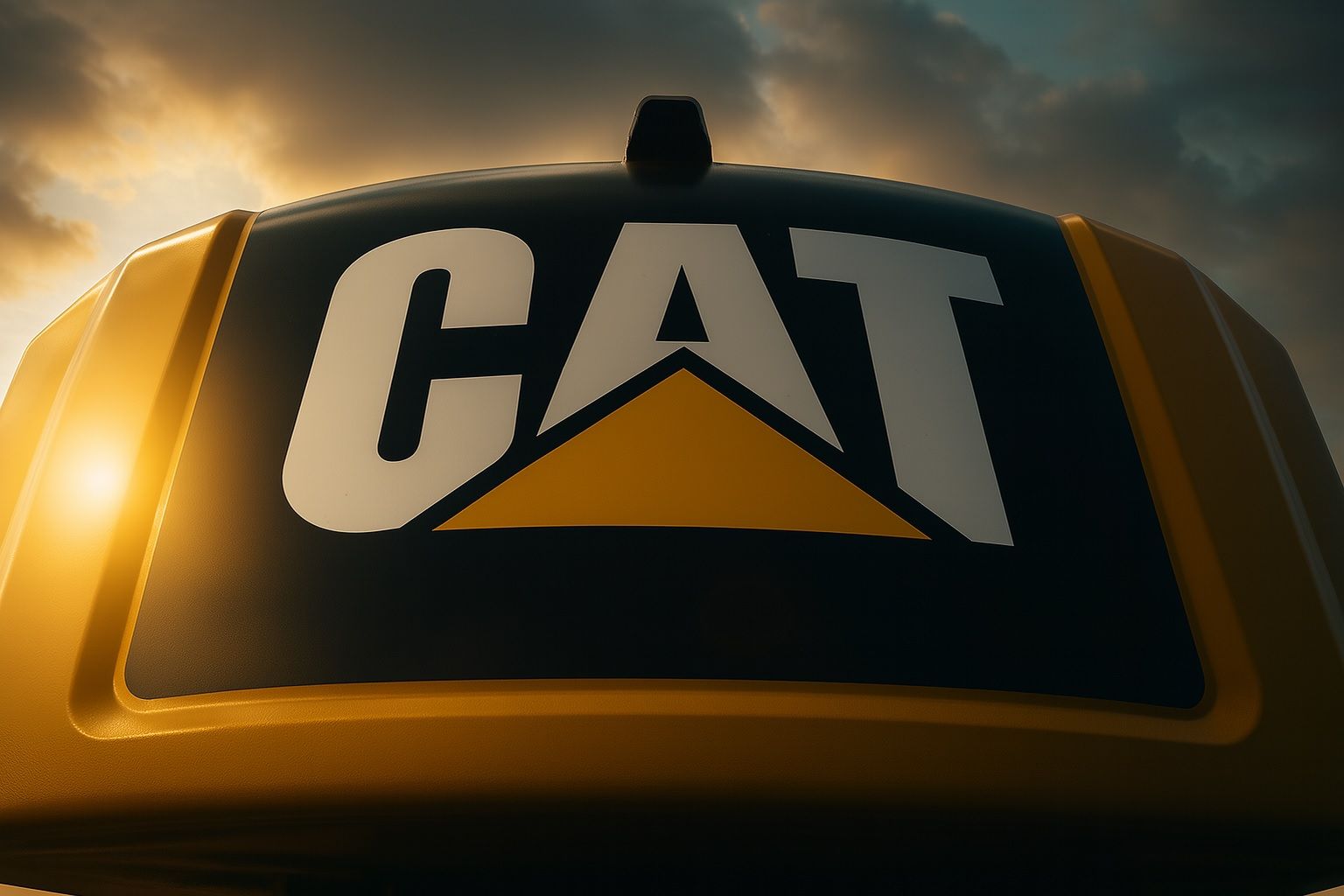- New Record High:Caterpillar (NYSE: CAT) stock surged nearly 5% on Oct. 14, 2025, reaching an intraday peak around $528, its highest price ever [1]. The construction and equipment giant’s shares are now up roughly 38% year-to-date, trouncing the S&P 500’s ~13% gain in the same period [2].
- Wall Street’s Big Bet – $650 Price Target:JPMorgan sparked the latest rally by raising its CAT price target to $650 (from $505) and reaffirming an “Overweight” buy rating [3]. This bold 28% upgrade – a Street-high target – ignited fresh investor enthusiasm. Other analysts have also boosted their outlooks; recent upgrades from Citigroup (~$570), Bank of America (~$517), and Erste Group (to Buy) underscore improving sentiment, though the consensus target is around $500 [4] [5].
- “Perfect Storm” of Growth Drivers: Caterpillar is riding a confluence of positive factors – from robust infrastructure spending to a booming AI-driven data center buildout. One market analyst noted “Caterpillar’s stock is surging on a perfect storm of strategic partnerships and technical momentum,” pointing to the major Wall Street upgrade, a data-center power deal, and M&A buzz as simultaneous catalysts [6]. Indeed, Caterpillar benefits both from cyclical trends (rebounding construction and energy projects) and secular themes like the AI data center boom driving demand for its large-scale generators [7].
- Strategic Deals Fueling Optimism: Recent big moves by Caterpillar have impressed investors. The company agreed to acquire RPMGlobal, an Australian mining software firm, for ~$1.1 billion – expanding CAT’s foothold in digital mining tech [8]. It also inked a partnership with Hunt Energy to develop 1 gigawatt of data center power capacity (with an initial Texas project), and joined a consortium on a 4 GW Utah data center project [9]. These deals position Caterpillar at the forefront of powering AI mega-projects, reinforcing its evolution from heavy machinery into a critical player in digital infrastructure [10]. “Caterpillar is uniquely positioned to tackle the growing energy needs for artificial intelligence… through integrated energy solutions,” said Melissa Busen, a Caterpillar VP, about the 4 GW data center project [11].
- Market Sentiment and Valuation:Investor mood is bullish but measured. At ~$528 per share, Caterpillar’s market cap is near $250 billion, and the stock trades around 26× trailing earnings, a premium to industrial peers [12]. That rich valuation reflects optimism about growth but also invites caution from some analysts who note the stock is no longer cheap [13]. Notably, insiders sold about 38,800 shares (~$17 million worth) in recent months (including the CEO trimming his stake) – often a sign of profit-taking at peak prices [14] [15]. However, this hasn’t spooked institutions: roughly 71% of CAT’s float is held by big investors like funds [16], and heavy buying volume during the rally suggests continued confidence. In fact, many on Wall Street still see upside – the average analyst rating is “Buy” and quantitative models score CAT as a high-momentum winner in the current market [17].
- Upcoming Earnings – Key Test Ahead: All eyes are on Caterpillar’s Q3 2025 earnings report due November 4, 2025 [18]. This will be a crucial check on whether fundamentals justify the stock’s huge run-up. Last quarter’s results were mixed – Q2 2025 saw adjusted profit of ~$4.72/share (a slight miss) on $16.6 billion revenue (a modest beat) [19]. Sales actually dipped ~1% year-on-year amid softer construction demand and tariff headwinds [20]. Even so, management raised its full-year outlook slightly, citing robust demand for power generation equipment (e.g. data center power systems) offsetting weaker segments [21]. If Q3 shows continued strength in order backlogs and margins – especially in high-growth areas – it could confirm the bull case. Any stumble or cautious 2026 guidance, however, might prompt a rethink given the stock’s lofty pricing.
Stock Rockets to Record High on AI Hype and Upbeat News
Caterpillar’s stock has been on a tear, and the momentum culminated on October 14 with a sharp 4.5% intraday jump to ~$528 – an all-time high [22]. The stock closed just shy of that peak, adding roughly $10 billion in market value in one day [23]. This milestone caps an extraordinary run in 2025: CAT shares have nearly doubled from their 52-week lows, vastly outperforming the broader market [24]. By mid-October, Caterpillar was up over 30% for the year, leaving the S&P 500’s ~13% gain in the dust [25]. Such outperformance from an industrial blue-chip underscores how company-specific catalysts – rather than just a rising market tide – have been driving the stock.
Notably, the latest surge came on a day when the overall market was mixed (the Dow up ~0.7% while tech stocks lagged) [26]. This divergence highlighted Caterpillar’s unique momentum: investors piled into CAT on good news specific to the company, even as many other stocks treaded water. Trading volume in Caterpillar spiked well above average, a sign of strong buying interest fueling the rally [27]. Options activity was also brisk, with a flurry of bullish call options trades around the $525–$530 strikes as traders bet on further upside [28]. Technically, the stock is extended – sitting nearly 40% above its 200-day moving average with short-term indicators in “overbought” territory [29]. That suggests the potential for a breather or pullback. Yet bullish investors note that in the past, Caterpillar often continued to climb in the weeks after similar big one-day jumps, giving optimists reason to ride the wave [30].
What’s Driving the Boom? From Infrastructure to AI Power
Several converging tailwinds have formed a perfect recipe for Caterpillar’s 2025 success. First, core end markets have rebounded: construction and mining activity globally have seen solid demand, helped by government infrastructure programs and high commodity prices. Caterpillar’s order books for bulldozers, excavators, and trucks remain robust thanks to U.S. infrastructure spending rollouts and ongoing resource projects worldwide [31]. The company has a $35 billion backlog of orders, reflecting infrastructure initiatives and renewed capital spending in energy and mining [32]. “Global infrastructure initiatives, coupled with renewed activity in resource extraction, have fueled a strong order book for Caterpillar,” noted one market report [33].
But the real X-factor driving Caterpillar’s stock to new heights is the AI revolution. In a somewhat unexpected twist, the century-old machinery maker has emerged as a beneficiary of the data center boom. Modern AI and cloud computing data centers consume enormous power, and Caterpillar’s Energy & Transportation division – which makes large generators and turbines (including its Solar Turbines subsidiary) – is in hot demand [34]. As tech giants race to build out AI infrastructure, they often require on-site power plants for reliability, creating a surge in orders for Caterpillar’s gas turbines and backup generators. “There’s just – the AI demand is massive and so people are putting in their own power plants at data centers… the whole world has changed,” observed Rob Wertheimer of Melius Research, discussing Caterpillar’s unique positioning in the AI era [35]. Bloomberg recently highlighted that investors have “shifted to Caterpillar (CAT) as an unexpected beneficiary of the AI buildout” as data center expansion boosts demand for CAT’s power equipment, effectively making the stock a proxy for data center spending [36]. In fact, power generation for data centers has become one of Caterpillar’s fastest-growing segments, helping its Energy & Transportation unit surpass the traditional Construction segment in revenue for the first time [37]. Jason Kaiser, Caterpillar’s Group President of E&T, noted that “power generation, which is where data centers fall, has been the main part of that growth” in the past year [38].
Caterpillar’s management has astutely pivoted to capitalize on this trend. The company has announced high-profile partnerships to supply turnkey power solutions for huge data centers. In August, CAT unveiled a deal with Hunt Energy Network to develop up to 1 GW of dedicated data center power capacity across North America [39] [40]. And in early October, it joined a consortium to equip a planned 4 gigawatt AI computing campus in Utah with its latest gas-fired generators and energy storage systems [41] [42]. These projects are massive – a 4 GW facility is like powering a small city – and they showcase how Caterpillar is extending its 100-year-old expertise into cutting-edge tech infrastructure. “As the storied construction giant celebrates its centennial, Caterpillar’s growth has evolved to fit the economic zeitgeist,” observed a Fortune analysis, noting that much of its new opportunity is tied to powering the data center boom and other emerging needs [43]. In other words, Caterpillar is proving it can innovate and remain relevant even in the digital age, which has further emboldened investors.
Meanwhile, traditional catalysts for Caterpillar haven’t gone away. The global push for infrastructure renewal – from U.S. highway projects to overseas development – continues to provide a steady backdrop of equipment demand. Higher oil & gas investment (partly driven by energy security needs) has also supported orders for Caterpillar’s engines and drilling equipment. And anticipation that interest rates may finally peak or start to ease in 2025–2026 has improved the outlook for financing big equipment purchases [44]. Lower borrowing costs would make it easier for contractors to upgrade fleets, so the mere hint of future Fed rate cuts has added to positive sentiment on industrial stocks. All told, Caterpillar is benefiting from a rare alignment of cyclical recovery and secular growth – an economic “sweet spot” that few could have predicted for a company often seen as just a bellwether of old-school industry.
Analysts Upbeat – Price Targets Climb as Outlook Brightens
Wall Street analysts have increasingly warmed up to Caterpillar, adding fuel to the rally with upbeat calls. The most attention-grabbing endorsement came from JPMorgan on Oct. 14: analyst Tami Zakaria not only jacked CAT’s price target to $650 (the highest on the Street) but also expressed confidence in the company’s strategic direction [45]. “Significant upside” remains, according to JPMorgan’s note, even after the stock’s recent surge [46]. This vote of confidence from a major bank acted as a catalyst, with Caterpillar’s stock spiking on the report’s release and helping propel it to record levels [47].
JPMorgan’s bold call is part of a broader trend of analyst upgrades in recent weeks. In early October, Erste Group upgraded Caterpillar from Hold to Buy, citing strong execution and margins [48]. Around the same time, Citigroup reiterated its Buy rating and lifted its target to $570, while Bank of America raised its target to $517 [49]. Even some previously cautious firms have grown more positive – in August, Barclays bumped its target to $425 (though keeping an Equal-Weight stance), and just recently Bernstein nudged up its target to ~$502 while maintaining a neutral view [50] [51]. As a result, the consensus analyst price target for CAT now sits around $493–$500 per share [52] [53]. That’s slightly below the current trading price, suggesting the average analyst was caught off-guard by the stock’s rapid ascent. Many analysts “may need to play catch-up” if Caterpillar continues outperforming [54]. Indeed, the two most recent analyst ratings now classify CAT as a “Strong Buy”, reflecting a distinctly bullish tilt in sentiment [55].
Why this surge of optimism? Analysts cite multiple factors: improving end-market trends, Caterpillar’s moves into high-growth areas (like data center power and digital solutions), and the company’s financial discipline. Caterpillar has been posting solid profit margins despite cost pressures – its trailing net profit margin is in the mid-teens, and return on equity is exceptionally high (~50%) [56] [57]. The company also rewards shareholders with steady dividends (~1.2% yield) and buybacks [58] [59], which boosts confidence. As Melius Research and others note, the expansion of CAT’s Solar Turbines business into AI data centers adds a new growth engine that wasn’t part of the story a few years ago [60]. “Strong profit margins, a substantial $35 billion backlog, and favorable economic trends” were key reasons cited by one investment firm that recently upped its target [61]. Another highlight: Caterpillar has increased its dividend annually for 32 years [62], a sign of stability that investors appreciate even as the company ventures into new arenas.
That said, not everyone is pounding the table at these prices. A few analysts urge caution on valuation and macro risks. With CAT’s price/earnings ratio now ~26 (well above its historical average), “the shares aren’t cheap, especially if global growth slows,” as some skeptics point out [63]. Those more neutral analysts worry that a lot of good news is already baked into the stock. If China’s construction market or North American equipment demand were to soften more than expected, Caterpillar’s earnings could disappoint the rosy forecasts. Thus far in 2025, CAT has defied the doubters – delivering better results than feared and repeatedly scaling new highs [64]. But the divergence in analyst opinions means the upcoming quarters will be critical to either validate the bulls or vindicate the cautious view.
Big Moves: Tech Partnerships, Acquisitions Bolster Growth Strategy
Beyond the macro tailwinds, Caterpillar’s own strategic initiatives have amplified investor enthusiasm. In 2025 the company has aggressively pursued partnerships and acquisitions aimed at future-proofing its business:
- Data Center Power Partnerships: Recognizing the opportunity in powering data centers, Caterpillar struck a notable alliance with Hunt Energy Network. This long-term partnership will develop up to 1 gigawatt of independent power capacity for data centers across North America [65]. The first project, in Texas, will deploy Caterpillar’s natural gas generators and battery storage to ensure reliable, round-the-clock energy for a large new data center [66]. Around the same time, Caterpillar announced it’s working with Joule Infrastructure and Wheeler Machinery (a local dealer) to supply a gigantic 4 GW high-performance computing campus in Utah with power systems [67]. Caterpillar will provide hundreds of its latest generators plus integrated energy storage to support this 4,000-acre AI-focused server farm [68] [69]. These deals illustrate CAT’s evolution into an “energy-as-a-service” provider for tech infrastructure. They not only generate immediate equipment sales, but also position Caterpillar as a go-to partner for data center operators – potentially leading to recurring revenue through maintenance contracts, fuel, and upgrades. Investors have cheered these moves as savvy “business beyond bulldozers,” expanding Caterpillar’s addressable market.
- Mining Technology Acquisition: Caterpillar is also doubling down on its bread-and-butter industries by adding more digital capabilities. Over the Oct. 14 weekend, CAT confirmed an agreement to acquire RPMGlobal Holdings, a leading Australian maker of mining software, for approximately A$5.00 per share in cash (A$403M, ~US$1.1 billion) [70] [71]. RPMGlobal’s products help mining companies with fleet management, resource planning, and equipment optimization [72]. Caterpillar stated that these tools complement its own mining machinery and autonomous systems, allowing more integrated solutions for customers [73]. “Their software solutions complement Caterpillar’s existing technologies… together we can enhance mine-site operations,” said Denise Johnson, CAT’s Resource Industries President, about the deal [74]. The acquisition, expected to close by early 2026, expands Caterpillar’s reach in the lucrative mining tech and services arena – where rival Komatsu and others have also been investing. For investors, it’s a signal that Caterpillar aims to be not just a seller of iron and steel, but a provider of the digital tools and automation that modern mining operations demand. This could drive higher-margin revenue (software and consulting) and deepen customer loyalty in the mining sector.
- Other Innovations and Investments: Caterpillar’s management hasn’t ignored other emerging trends either. The company has been showcasing prototypes of electric and hydrogen-powered machinery to prepare for a lower-carbon future [75]. It’s involved in partnerships on alternative fuels and electrified equipment to ensure its product line-up evolves with environmental mandates. Additionally, CAT invested heavily over the past year to beef up its supply chain capacity – from parts inventory to component production – after facing bottlenecks in 2022–2023. “The supply chain has been tough,” Caterpillar admitted, explaining that it ramped up capital spending to overcome shortages of semiconductors and other inputs [76]. These behind-the-scenes moves, while not as flashy as a big acquisition, have helped CAT fulfill strong demand despite global logistics challenges. By increasing factory throughput and securing critical components, Caterpillar managed to shorten lead times, which in turn supported more sales. Such operational improvements give investors confidence that CAT can execute on the growth opportunities it’s pursuing.
All these strategic initiatives align with a clear theme: Caterpillar is adapting for its next century. In 2025, the company celebrated its 100-year anniversary, but rather than rest on legacy businesses, it’s pushing into new high-growth frontiers. This narrative of an “old economy” icon finding fresh life in modern markets (like data centers, automation, and clean energy) has become a part of the bullish thesis. It’s not often that heavy machinery companies are seen as innovators, but Caterpillar’s recent moves have earned it that reputation – one analyst remarked that CAT’s bold bets have set it “as the sector’s innovation leader” among industrials [77]. That perception has no doubt contributed to the stock’s re-rating higher.
Challenges & Risks: Tariffs, Rates, and Economic Cycles
Amid the euphoria, it’s important to remember Caterpillar faces headwinds too. The company operates in cyclical markets and is exposed to global economic and political risks that could curtail its boom if conditions change:
- Trade War Costs: Tariffs have become a significant drag on Caterpillar’s costs. Many of CAT’s components (like sensors and electronics) are sourced from abroad, and ongoing U.S.–China trade disputes (and other tariffs on imports) are hitting the bottom line. In fact, Caterpillar recently raised its estimate of 2025 tariff-related costs to as much as $1.8 billion (from an earlier $1.5B), after new levies were announced mid-year [78] [79]. Management warned that these tariffs are squeezing profit margins – the additional costs could push CAT’s operating margin to the lower end of its target range for the year [80]. The company said it’s taking mitigating actions and adjusting pricing to offset some impact [81] [82], but it’s a delicate balance. “Sweeping tariffs have raised costs across Caterpillar’s supply chain,” Reuters noted, and industrial firms have struggled to fully pass these costs to customers in a weak demand environment [83] [84]. If trade tensions escalate further (for example, China retaliating or restricting exports of critical materials), Caterpillar could face higher input prices or supply disruptions. During the Oct 14 rally, CAT actually shrugged off some broader market jitters about U.S.–China friction that day [85], but geopolitical risks remain a background concern for investors.
- High Interest Rates and Cooldown in Construction: The flip side of potential future rate cuts is that current interest rates remain high, after aggressive central bank tightening. Elevated borrowing costs have already started to cool construction activity in the U.S. and other regions [86]. Caterpillar has flagged a “slowdown in U.S. construction spending due to higher rates,” which contributed to slight declines in its North American equipment sales in mid-2025 [87]. Likewise, in Asia-Pacific, construction demand has been soft, with CAT’s sales in those markets down a few percent year-over-year [88]. If inflation remains persistent and central banks keep rates higher for longer, major building projects (from real estate to mining expansion) could be deferred or scaled back, dampening Caterpillar’s order flow. There’s also the risk of a broader economic slowdown or recession heading into 2026 – many economists expect growth to moderate. As a cyclical company, Caterpillar would likely feel the pinch if global GDP or capital investment dips. Already, Caterpillar’s own executives have observed some customers becoming more cautious: “We suspect that customers are opting to rent equipment over direct purchases amid macroeconomic uncertainty, cutting into sales of CAT machinery,” noted CFRA Research analyst Jonathan Sakraida earlier this year [89]. Such behavior, if widespread, could weigh on Caterpillar’s new equipment sales (though CAT’s finance arm and used equipment business might offset some of that).
- China and Emerging Markets: Caterpillar derives a significant portion of its revenue from outside North America, including China, Latin America, and other emerging markets. China’s economy in particular is a wildcard – a large chunk of CAT’s mining and construction equipment sales depend on Chinese demand. Lately, China’s property construction sector has been weak, and its overall growth has been uneven. Any further slowdown in China’s infrastructure or mining investment would be a headwind for Caterpillar. On the other hand, a stimulus or infrastructure push by Beijing could quickly translate into a boost for machinery orders. Investors will be listening closely during the Q3 earnings call for any commentary on China’s trends and dealer inventory levels in Asia [90] [91].
- Operational Challenges: While Caterpillar has managed its supply chain better than some peers, challenges remain. Shortages of specific parts (chips, batteries, etc.), logistics bottlenecks, or labor constraints could hamper CAT’s ability to deliver on its record backlog. Also, integrating acquisitions like RPMGlobal will take time and entails execution risk – shareholders will want to see those investments pay off as projected. Finally, currency fluctuations (with a strong U.S. dollar in 2025) can dent overseas profits when converted back to dollars.
In short, Caterpillar is not without risks, and its management has openly acknowledged several of these. The company’s most recent guidance called for full-year 2025 revenue to be only “slightly higher” than 2024, with operating profit margins in the lower half of the target range (partly due to tariffs) [92] [93]. Hitting even that tempered outlook will require solid execution in Q3 and Q4. Any disappointment or cautious commentary (for example, if CAT signals 2026 could be softer) might trigger some profit-taking in the stock given how much optimism is currently priced in.
Investor Outlook: Cautious Optimism into Year-End
Going forward, the consensus on Wall Street is one of cautious optimism. Caterpillar’s stunning run in 2025 has reestablished it as a market darling, and many believe the company has more room to grow – albeit at a more moderate pace. Bulls argue that Caterpillar’s exposure to multiple strong trends (infrastructure spending, energy transition projects, data center buildouts, mining modernization) gives it a long runway for revenue expansion beyond the current economic cycle [94] [95]. They also laud CAT’s operational excellence: despite headwinds, the company has maintained healthy margins and returns, indicating it can capitalize on opportunities while controlling costs [96]. If the global economy avoids a hard landing and project spending continues, Caterpillar could ride those tailwinds to higher earnings in 2026 and beyond. Some models even flag Caterpillar as a uniquely attractive stock at the moment – for instance, a quantitative screen for low-volatility, high-momentum stocks recently gave CAT a “100% score” and a “strong interest” rating, an unusually perfect mark [97].
However, even optimists usually attach a note of caution. The stock’s elevated valuation means expectations are high; any slip-up in execution or demand could lead to a pullback. Wall Street forecasts currently anticipate full-year 2025 earnings around $19.80 per share, which actually represents a slight decline from 2024’s peak EPS [98]. Growth is expected to resume in 2026, but those projections hinge on an economic uptick and successful integration of new ventures. In other words, Caterpillar has to deliver on the hype to justify its stock price. The upcoming Q3 earnings report (and management’s tone about the backlog and 2026 pipeline) will be the next major inflection point. A solid beat and confident outlook could push the stock higher again, perhaps edging closer to that $650 bull-case target. On the flip side, any hint of softness – say, order delays or margin pressure – might prompt analysts to tap the brakes.
For now, the sentiment is that Caterpillar’s story straddles two worlds – heavy industry and high-tech – and that blend is paying off. As one commentator put it, Caterpillar in 2025 is a “hot stock at the intersection of heavy machinery and high tech”, a rare mix that investors find compelling [99]. The company’s centennial slogan could well be about building the future, not just roads and bridges but also the infrastructure of the digital age. If management continues to execute, today’s record highs might just be a stepping stone. As JPMorgan’s analysts implied with their headline-grabbing call, this industrial giant’s run may not be over yet [100].
Sources: Recent market analysis and company news from TS2.Tech [101] [102], Reuters [103] [104], Bloomberg [105], Yahoo Finance/constructforstl [106], and Caterpillar’s own releases. Financial data and analyst commentary from MarketBeat, Reuters, and company filings [107] [108]. (All linked sources provide direct support for the facts and quotes in this article.)
References
1. ts2.tech, 2. ts2.tech, 3. ts2.tech, 4. ts2.tech, 5. ts2.tech, 6. ts2.tech, 7. ts2.tech, 8. ts2.tech, 9. ts2.tech, 10. ts2.tech, 11. ts2.tech, 12. ts2.tech, 13. ts2.tech, 14. ts2.tech, 15. ts2.tech, 16. ts2.tech, 17. ts2.tech, 18. ts2.tech, 19. ts2.tech, 20. ts2.tech, 21. ts2.tech, 22. ts2.tech, 23. ts2.tech, 24. ts2.tech, 25. ts2.tech, 26. ts2.tech, 27. ts2.tech, 28. ts2.tech, 29. ts2.tech, 30. ts2.tech, 31. ts2.tech, 32. markets.financialcontent.com, 33. markets.financialcontent.com, 34. markets.financialcontent.com, 35. www.facebook.com, 36. blockchain.news, 37. ts2.tech, 38. ts2.tech, 39. ts2.tech, 40. ts2.tech, 41. ts2.tech, 42. ts2.tech, 43. ts2.tech, 44. markets.financialcontent.com, 45. ts2.tech, 46. ts2.tech, 47. ts2.tech, 48. ts2.tech, 49. ts2.tech, 50. ts2.tech, 51. ts2.tech, 52. markets.financialcontent.com, 53. ts2.tech, 54. ts2.tech, 55. ts2.tech, 56. ts2.tech, 57. ts2.tech, 58. ts2.tech, 59. markets.financialcontent.com, 60. markets.financialcontent.com, 61. markets.financialcontent.com, 62. markets.financialcontent.com, 63. ts2.tech, 64. ts2.tech, 65. ts2.tech, 66. ts2.tech, 67. ts2.tech, 68. ts2.tech, 69. ts2.tech, 70. ts2.tech, 71. ts2.tech, 72. ts2.tech, 73. ts2.tech, 74. ts2.tech, 75. ts2.tech, 76. ts2.tech, 77. ts2.tech, 78. www.reuters.com, 79. www.reuters.com, 80. www.reuters.com, 81. www.reuters.com, 82. www.reuters.com, 83. www.reuters.com, 84. www.reuters.com, 85. ts2.tech, 86. ts2.tech, 87. ts2.tech, 88. ts2.tech, 89. www.reuters.com, 90. ts2.tech, 91. ts2.tech, 92. ts2.tech, 93. ts2.tech, 94. ts2.tech, 95. ts2.tech, 96. ts2.tech, 97. ts2.tech, 98. ts2.tech, 99. ts2.tech, 100. ts2.tech, 101. ts2.tech, 102. ts2.tech, 103. www.reuters.com, 104. www.reuters.com, 105. blockchain.news, 106. ts2.tech, 107. ts2.tech, 108. ts2.tech







